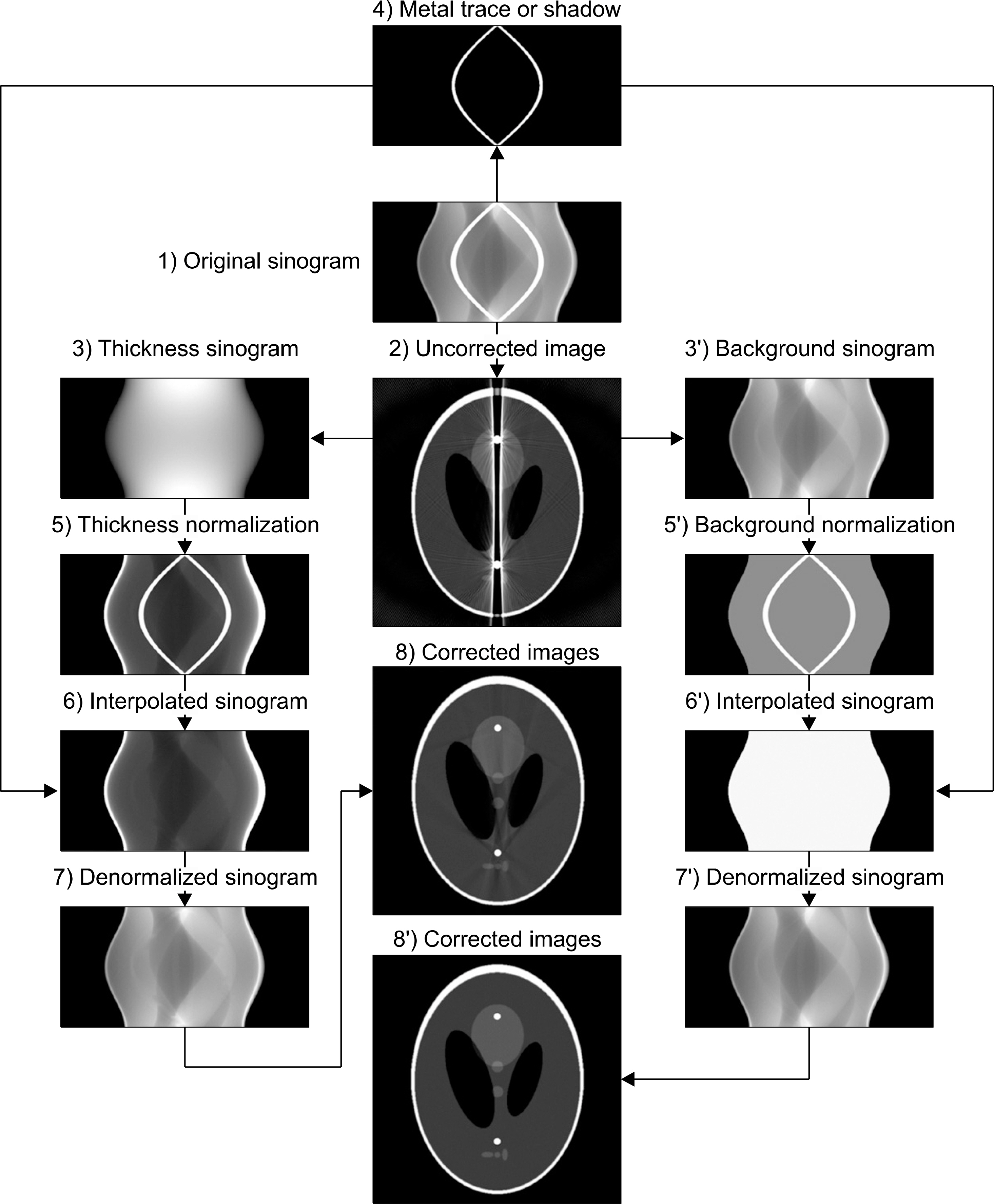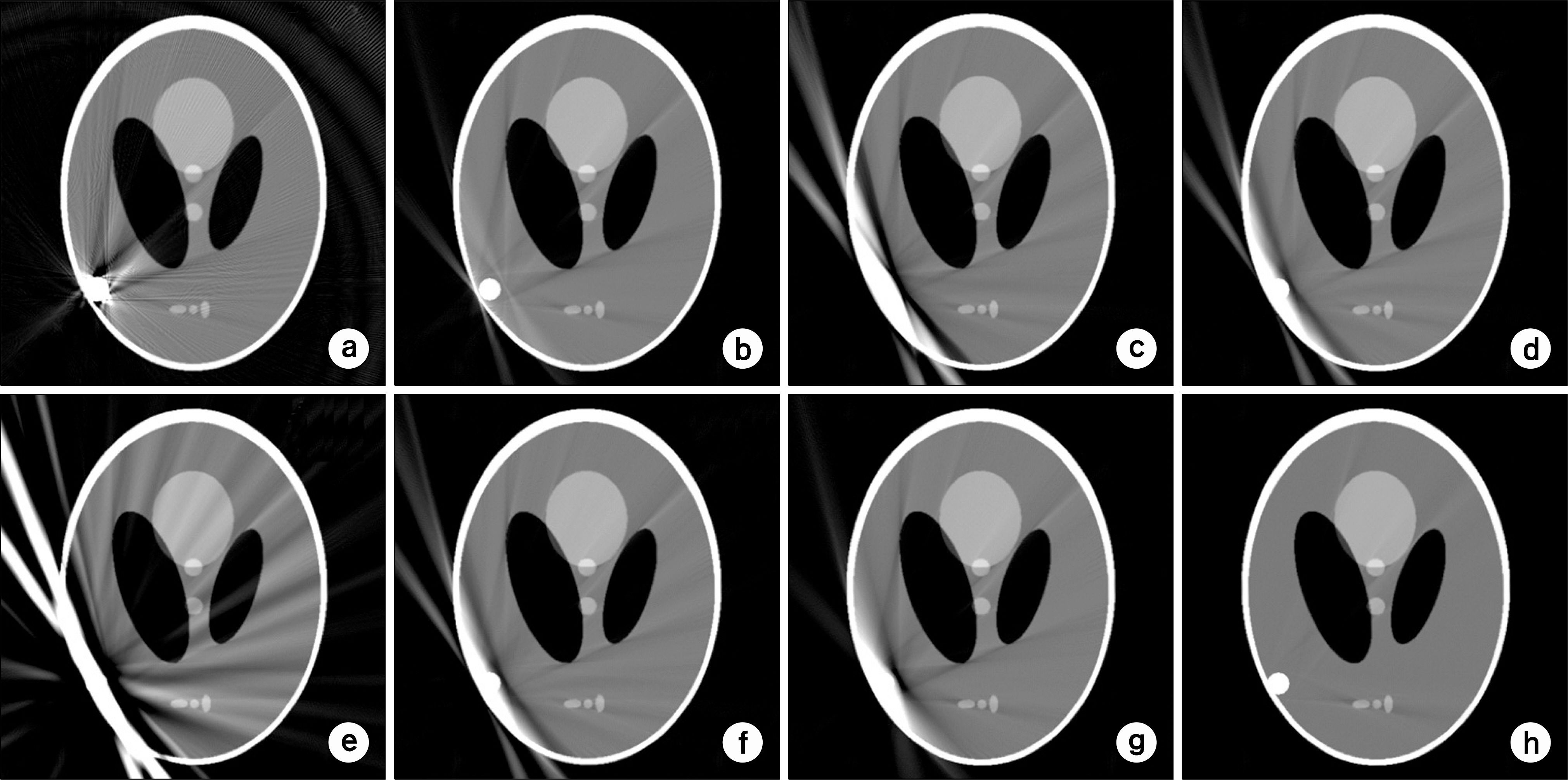Prog Med Phys.
2013 Dec;24(4):303-314. 10.14316/pmp.2013.24.4.303.
Theoretical Investigation of Metal Artifact Reduction Based on Sinogram Normalization in Computed Tomography
- Affiliations
-
- 1Department of Radiation Oncology, Pusan National University Yangsan Hospital, Yangsan, Korea.
- 2School of Mechanical Engineering, Pusan National University, Busan, Korea. hokyung@pusan.ac.kr
- 3Advanced Medical Engineering Research Center, Pusan National University, Busan, Korea.
- KMID: 1910574
- DOI: http://doi.org/10.14316/pmp.2013.24.4.303
Abstract
- Image quality of computed tomography (CT) is very vulnerable to metal artifacts. Recently, the thickness and background normalization techniques have been introduced. Since they provide flat sinograms, it is easy to determine metal traces and a simple linear interpolation would be enough to describe the missing data in sinograms. In this study, we have developed a theory describing two normalization methods and compared two methods with respect to various sizes and numbers of metal inserts by using simple numerical simulations. The developed theory showed that the background normalization provide flatter sinograms than the thickness normalization, which was validated with the simulation results. Numerical simulation results with respect to various sizes and numbers of metal inserts showed that the background normalization was better than the thickness normalization for metal artifact corrections. Although the residual artifacts still existed, we have showed that the background normalization without the segmentation procedure was better than the thickness normalization for metal artifact corrections. Since the background normalization without the segmentation procedure is simple and it does not require any users' intervention, it can be readily installed in conventional CT systems.
MeSH Terms
Figure
Reference
-
1. Parker RP, Hobday PA, Cassell KJ. The direct use of CT numbers in radiotherapy dosage calculations for inhomogeneous media. Phys Med Biol. 24(4):802–809. 1979.
Article2. Guerrero ME, Jacobs R, Loubele M, et al. State-ofthe- art on cone beam CT imaging for preoperative planning of implant placement. Clin Oral Invest. 10(1):1–7. 2006.3. Cho MK, Kim HK, Youn H, Kim SS. A feasibility study of digital tomosynthesis for volumetric dental imaging. J Instrum. 7(3):P03007. 2012.
Article4. Glover GH, Pelc NJ. An algorithm for the reduction of metal clip artifacts in CT reconstructions. Med Phys. 8(6):799–807. 1981.
Article5. Kalender WA, Hebel R, Ebersberger J. Reduction of CT artifacts caused by metallic implants. Radiology. 164(2):576–577. 1987.
Article6. Wang G, Snyder DL, O'Sullivan JA, et al. Iterative deblurring for CT metal artifact reduction. IEEE Trans Med Imaging. 15(5):657–664. 1996.7. De Man B, Nuyts J, Dupont P, et al. An iterative maximum- likelihood polychromatic algorithm for CT. IEEE Trans Med Imaging. 20(10):999–1008. 2001.8. Kachelrieβ M, Watzke O, Kalender WA. Generalized multi-dimensional adaptive filtering for conventional and spiral single-slice, multislice, and cone-beam CT. Med Phys. 28(4):475–490. 2001.9. Nuyts J, De Man B, Fessler JA, et al. Modelling the physics in the iterative reconstruction for transmission computed tomography. Phys Med Biol. 58(12):R63–R96. 2013.
Article10. Park JC, Song B, Kim JS, et al. Fast compressed sensing- based CBCT reconstruction using Barzilai-Borwein formulation for application to online IGRT. Med Phys. 39:1207–1217. 2012.11. Choi J, Kim KS, Kim MW, et al. Sparsity driven metal part reconstruction for artifact removal in dental CT. J X-ray Sci Tech. 19(4):457–475. 2011.
Article12. Müller J, Buzug TM. Spurious structures created by interpolation- based CT metal artifact reduction. Proc SPIE. 7258:72581Y(8pp). 2009.13. Müller J, Buzug TM. Intersection Line Length Normalization in CT Projection Data. Bildverarbeitung fur die Medizin;Berlin: 2008. p. 77–81.14. Meyer E, Raupach R, Lell M, Schmidt B, Kachelrieβ M. Normalized metal artifact reduction (NMAR) in computed tomography. Med Phys. 37(10):5482–5493. 2010.
Article15. Jain AK. Fundamentals of Digital Image Processing. Prentice-Hall Inc;Englewood Cliffs, NJ: 1989. ), pp.p. 438–439.16. Otsu N. A threshold selection method from gray-level histograms. IEEE Trans Syst Man Cybern. 9(1):62–66. 1979.
Article17. Sezgin M, Sankur B. Survey over image thresholding techniques and quantitative performance evaluation. J Electron Imaging. 13(1):146–165. 2004.
- Full Text Links
- Actions
-
Cited
- CITED
-
- Close
- Share
- Similar articles
-
- Metal artifact production and reduction in CBCT with different numbers of basis images
- Reduction of Metal Artifact around Titanium Alloy-based Pedicle Screws on CT Scan Images: An Approach using a Digital Image Enhancement Technique
- Convolutional Neural Network Based Sinogram Extrapolation for Truncated CT: Preliminary Study
- U-net based metal segmentation on projection domain for metal artifact reduction in dental CT
- Fluorodeoxyglucose Positron-Emission Tomography/Computed Tomography and Magnetic Resonance Imaging for Adverse Local Tissue Reactions near Metal Implants after Total Hip Arthroplasty: A Preliminary Report








